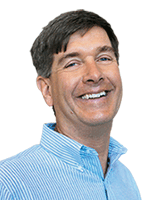Is a cool-season grass, unmown playable rough a reality?
Tom Voigt, Ph.D., is a turfgrass scientist at the University of Illinois. He has conducted numerous research projects on unmown, playable rough on golf courses and at research stations. He can be reached at tvoigt@illinois.edu for more information.

Cark Throssell. Ph.D.
Q: So, is a cool-season grass, unmown, playable rough a reality?
In the Midwest, so far, the answer is no. To achieve an acceptable cool-season grass, unmown, playable rough, the stand must have a low density and a low growth rate so golfers easily can find their golf ball and have an opportunity to make a successful shot. In the Midwest, cool-season grasses have the good fortune of many resources (precipitation and fertile soils) and as a result, form dense stands of grass that grow throughout the season. This means golfers have a difficult time finding their golf ball, and playing a shot becomes extremely challenging even for good golfers.
In short, cool-season grasses performed too well in our field plots. They were too dense and grew too fast to make an acceptable unmown, playable rough. We tried warm-season grasses, like buffalograss and blue grama. While they were closer to providing an unmown, playable rough, they greened up so late in spring/early summer that golfers would not accept a warm-season grass rough.
In some parts of the country and the world, like Ireland, Scotland and England, an unmown, playable rough may be possible. Being successful takes the right combination of enough water to sustain the grass, but not enough water for active growth during a majority of the growing season, together with soils that will support growth, but not lush growth. This is a difficult balance to find naturally or recreate. Grasses on these courses are often subjected to windy conditions, salt spray and highly drained sandy soils.
Q: What about fine fescue for an unmown, playable rough in the Midwest?
Fine fescue in our research in Illinois under non-irrigated conditions was still too dense and grew too much to make an acceptable unmown, playable rough. In addition, after fine fescue produced seedheads it tended to fall over and make a dense mat. This dense mat of grass was not attractive, and golfers had a difficult time finding their golf ball and playing a shot.
Perhaps at ultra-low seeding rates, possibly 5 pounds per acre, it may be possible to develop a thin stand of fine fescue that would work as an unmown, playable rough. It is an idea that needs more research. At an ultra-low seeding rate, however, weeds would likely present greater problems.
Q: What options are there for unmown, cool-season grass, out-of-play areas?
We have had success with a mixture of the cool-season grasses orchardgrass, timothy, redtop and tall fescue for unmown, out-of-play areas. Advantages to this mixture are that it greens up early in spring, looks presentable from a distance, the seedheads are attractive, broadleaf weeds are relatively easy to control and the height of the grass provides a nice visual contrast to the short-mowed turf. In addition, this grass mixture is a faster and cheaper way to define a golf course than planting trees and waiting for them to mature, and the unmown grass areas increase biodiversity.
The downside to these unmown, unplayable areas is a decrease in the pace of play unless they are truly located where nobody hits a golf ball, and perhaps the creation of habitat for nuisance animals.
Q: What maintenance is required for unmown, cool-season grass, out-of-play areas?
A minimum of one mowing per year, in September, with removal of the “hay” that is cut is essential. If desired, a second mowing in April, again removing the hay that is cut, is fine. Broadleaf weed control, either hand removal or herbicide application or both, will be needed.








